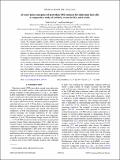Ab initio defect energetics of perovskite (001) surfaces for solid oxide fuel cells: A comparative study of LaMnO[subscript 3] versus SrTiO[subscript 3] and LaAlO[subscript 3]
Author(s)
Lee, Yueh-Lin; Morgan, Dane
DownloadPhysRevB.91.195430.pdf (3.853Mb)
PUBLISHER_POLICY
Publisher Policy
Article is made available in accordance with the publisher's policy and may be subject to US copyright law. Please refer to the publisher's site for terms of use.
Terms of use
Metadata
Show full item recordAbstract
In this paper, we perform a comparative study based on ab initio modeling for perovskite ABO[subscript 3] (001) surfaces and surface defect energetics in order to understand the influence of polarity and redox active Mn in the LaMnO[subscript 3] system. We consider LaMnO[subscript 3],LaAlO[subscript 3],SrTiO[subscript 3], and briefly LaFeO[subscript 3] systems for comparison, which illustrate the interplay between properties of polar surfaces and the varying d-electron shell of transition metals. We are motivated by the need to understand the surfaces of mixed electronic and ionic conductors typically used in solid oxide fuel cell cathodes and other ion conducting technologies, which are represented here by the LaMnO[subscript 3] system. We focus on the influence of the metal character and surface polarity on the surface and surface defect chemistry in these selected systems. We demonstrate that the facile redox of the TM (3d[superscript 4]) in LaMnO[subscript 3] with partial e[subscript g] orbital occupation (or specifically e[subscript g] occupancy close to 1) allows the polar surfaces to be compensated by changes in charge density over relatively short length scales (3 to 4 unit cells or ~1.5 nm) near the surface as compared to LaAlO[subscript 3]. In contrast to LaAlO[subscript 3], this low-energy and short-range screening mechanism leads to low surface energies without any additional reconstruction, rapidly converging surface properties with film thickness (by ~8 unit cells), bulklike defect chemistry more than ~1.5 nm from the surface, and surface defect energetics that are primarily governed by the local charge doping or the created electric field near the polar surfaces. We show that LaMnO[subscript 3] exhibits very different surface properties from LaAlO[subscript 3] and SrTiO[subscript 3], thereby demonstrating that these properties are due to the presence of the redox active transition metal with partial e[subscript g] orbital occupation and a polar surface, respectively. These understandings can help guide qualitative analysis, computational study, and design of surfaces of mixed electronic and ionic conductors.
Date issued
2015-05Department
Massachusetts Institute of Technology. Department of Mechanical Engineering; Massachusetts Institute of Technology. Electrochemical Energy Laboratory; Massachusetts Institute of Technology. Research Laboratory of ElectronicsJournal
Physical Review B
Publisher
American Physical Society
Citation
Lee, Yueh-Lin, and Dane Morgan. “Ab Initio Defect Energetics of Perovskite (001) Surfaces for Solid Oxide Fuel Cells: A Comparative Study of LaMnO[subscript 3] Versus SrTiO[subscript 3] and LaAlO[subscript 3].” Phys. Rev. B 91, no. 19 (May 2015). © 2015 American Physical Society
Version: Final published version
ISSN
1098-0121
1550-235X